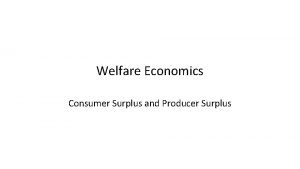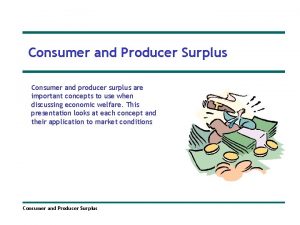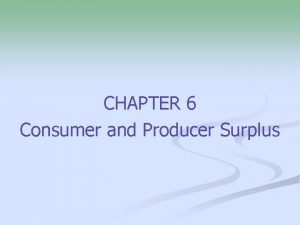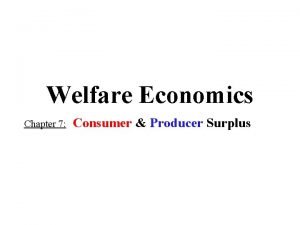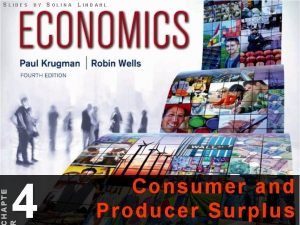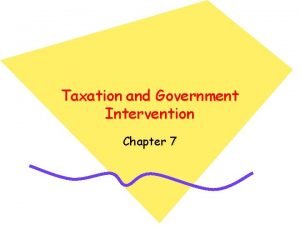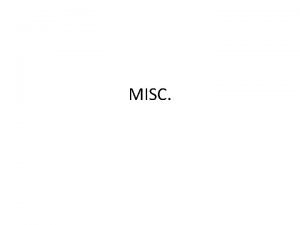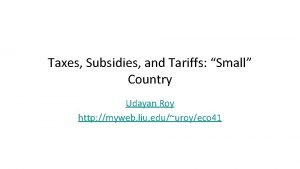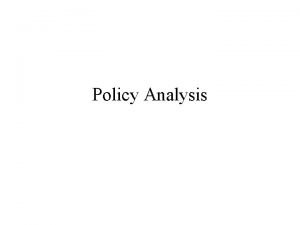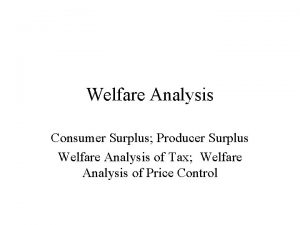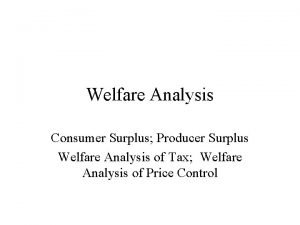Welfare Economics Chapter 7 Consumer Producer Surplus CONSUMER











- Slides: 11

Welfare Economics Chapter 7: Consumer & Producer Surplus

CONSUMER SURPLUS • Consumer Surplus (CS) = measures the welfare of the buyer • CS = maximum price a buyer is willing to pay minus price paid • Demand Curve = Marginal Benefit Curve – CS = MB – Price Paid

Demand Schedule & the Demand Curve Demand curves depicts the quantity buyers are willing to pay at each price Consumers value goods differently The demand curve is essentially a marginal benefit curve

Individual Consumer Surplus Price of Album @ Equilibrium Price = $70 $100 John’s consumer surplus ($30) 80 Paul’s consumer surplus ($10) P 1 70 Total 50 consumer surplus ($40) Demand 0 1 2 3 4 Quantity of Albums

Total Consumer Surplus Price $200 A The triangle above current market price is the“welfare” of all consumers Total Consumer Surplus @ $100 price = $10 Consumer Surplus $100 B ½ * 1 * 20 = $10 C D 1 = MB 1 0 20 Quantity [½ base * height]

Consumer Surplus Handout • Please complete Consumer Surplus worksheet

Producer Surplus • Producer Surplus (PS) = measures the welfare of the seller • PS = price received minus minimum price firms will sell good/service • Supply = Marginal Cost Curve – PS = Price Received - MC

Rising Prices & Producer Surplus Price Supply = MC Additional producer surplus to initial producers P 2 P 1 D E As Price Producer Surplus F B Initial producer surplus C Producer surplus to new producers A 0 Q 1 Q 2 Quantity

Welfare Economics is the study of whether a market allocation is socially desirable (MB = MC) • equilibrium maximizes total welfare for society unless there is a market failure – (i. e. externalities, price fixing, etc…) S = Marginal Cost (MC) D = Marginal Benefit (MB)

EFFICIENCY vs. EQUITY • Efficiency = an allocation which maximizes the Total Surplus – Total Surplus = Consumer Surplus + Producer Surplus • Equity = the fairness of the distribution of well-being among the various buyers and sellers – Equity is not addressed in free markets • Market equilibrium quantity maximizes *Total Welfare – * assuming no market failures such as externalities, price collusion, fraud, etc….

Producer Surplus & Total Welfare & Surplus are interchangeable terms ( i. e. Total Welfare is same as Total Surplus)
 Producer surplus
Producer surplus Consumer and producer surplus
Consumer and producer surplus Producer surplus tax
Producer surplus tax Total producer surplus formula
Total producer surplus formula When are consumer and producer surplus maximized?
When are consumer and producer surplus maximized? Total surplus formula
Total surplus formula Interpreting food webs worksheet
Interpreting food webs worksheet Taxation and government intervention
Taxation and government intervention How to calculate consumer surplus
How to calculate consumer surplus Tariffs deadweight loss
Tariffs deadweight loss Consumer surplus with subsidy
Consumer surplus with subsidy Consumer surplus with subsidy
Consumer surplus with subsidy
